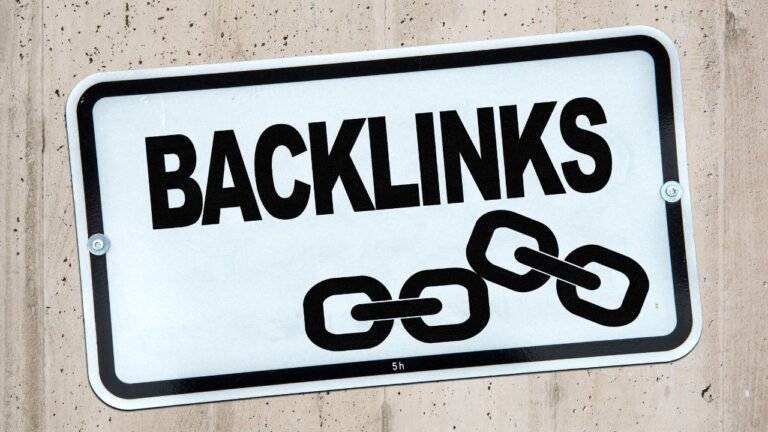Master On-Page SEO: Powerful Tips for 2025 Success
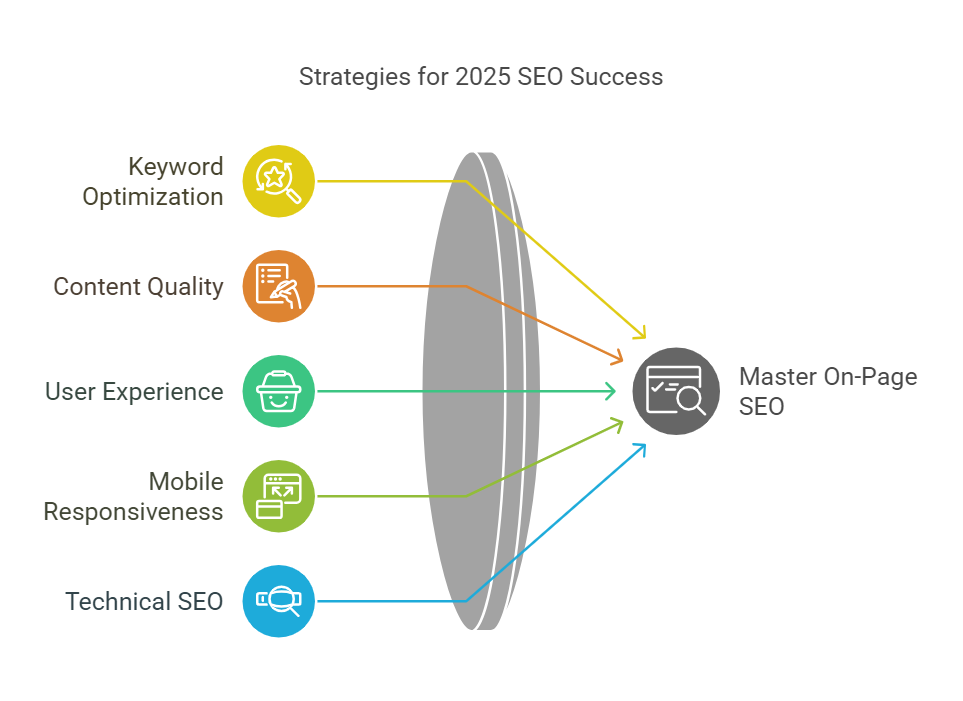
“Master On-Page SEO: Powerful Tips for 2025 Success” offers practical strategies to enhance website visibility and user engagement through updated SEO practices.
Here’s your on-page SEO guide for 2025, all about mastering the key elements that can boost or bust your website rankings.
So, let’s break it down together:
- Creating Content That Feels Right: Think of your website like a welcoming home for your visitors. You want them to come in and feel comfortable, right? That’s your content. Make it approachable, easy to read, and something that answers their questions before they even ask.
- URLs That Work Harder Than Just Links: Your URLs should be more than just addresses; they should be mini-ads! Make them snappy and relevant so people want to click.
- Titles That Tempt: Ever see a headline that just makes you need to click? That’s your goal. Craft titles that catch the eye and make promises your content actually keeps.
- Unique Content That Adds Value: Don’t just rehash what’s out there. Offer fresh insights or take a new angle on tired topics. It’s like telling a familiar story with a twist that keeps your friends hanging on your words.
- Strategic Keyword Use: It’s like a treasure hunt. Place your keywords where they’ll do the most good: in titles, headers, and sprinkled naturally throughout your content. But keep it natural—no stuffing!
And there’s more to it, but let’s start here. Are you ready to make your website the place to be in 2025? Let’s get rolling!
On-Page SEO Basics
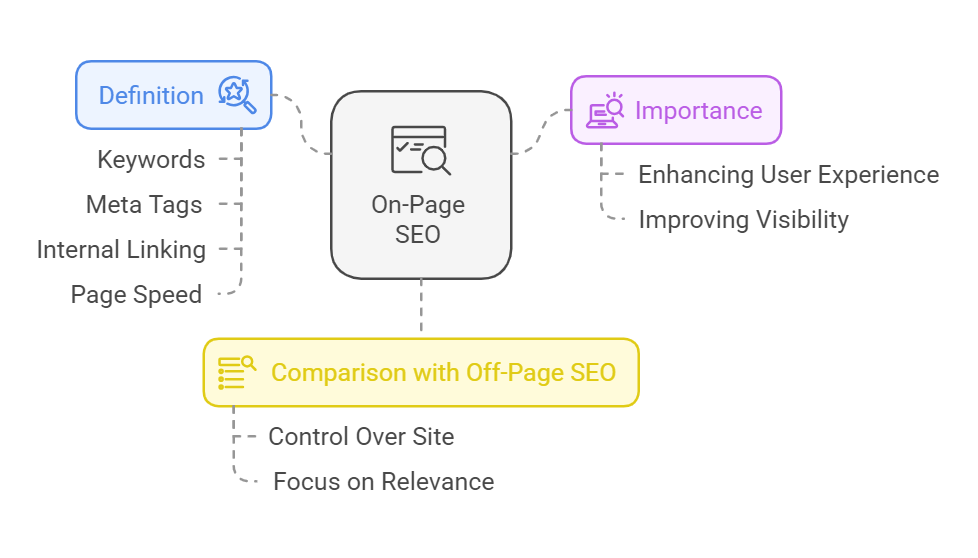
Welcome to the starting line of your on-page SEO adventure for 2025!
In this chapter, I’m going to break down why mastering on-page SEO is still crucial if you want your site to shine online. If you’ve been searching for ways to boost your site’s visibility and improve user experience, you’re in the right spot.
What is On-Page SEO?
Simply put, on-page SEO is all about making your web page irresistible to both search engines and real people. It’s the nitty-gritty stuff like tweaking your title tags, crafting engaging content, fixing up your internal links, and making your URLs snappy.
Unlike off-page SEO, which deals with external factors like backlinks and social media influence, on-page SEO is all about the enhancements you can control directly on your site.
Here’s a quick look at how on-page and off-page SEO stack up:
| Aspect | On-Page SEO | Off-Page SEO |
|---|---|---|
| Definition | Optimization of elements on your website | Strategies outside your website to enhance authority and visibility |
| Goal | Boost page-specific visibility and relevance | Increase overall website authority and trustworthiness |
| Examples | Keywords, Meta Tags, Internal Linking, Page Speed | Link Building, Social Media, Guest Posting, Public Relations |
Why Does On-Page SEO Matter?
Think of on-page SEO as your site’s handshake with Google. It’s how you tell the search giant what your content is about using the language it understands best—keywords. But there’s a twist; it’s not just about stuffing keywords everywhere. It’s about setting up a welcoming environment for your visitors so they find exactly what they need without getting lost.
To stay ahead in 2025, you’ll want to ensure your site excels in:
- User experience
- Bounce rate and dwell time
- Search intent
- Page loading speed
- Click-through rate
- Compatibility with both desktop and mobile devices
Consider on-page SEO as your secret sauce—not just a checklist but a dynamic strategy to stand out and make both Google and your visitors nod in approval.
How to Nail On-Page SEO
Back in the old days, on-page SEO might have been about hitting a few technical points and calling it a day. Not anymore. Now, it involves a more detailed approach to make your content not just fine, but fantastic.
Tools like Semrush’s On-Page SEO Checker are game changers. They don’t just tell you to sprinkle your keywords around; they offer real insights and practical tips to boost your content’s relevance and SEO strength.
On-Page SEO Template
And because we all need a little help keeping track of things, here’s an on-page SEO template you can download. I use it myself to ensure I don’t miss any steps, like making sure my primary keyword pops up in an H2 tag. With this checklist in one tab and my site in another, I make every step count.
There you have it—your guide to on-page SEO in 2025. Whether you’re tweaking an old page or crafting a new one, these insights will help you lay a solid foundation for success. Let’s make your website work smarter, not harder!
Optimize Title and Description Tags
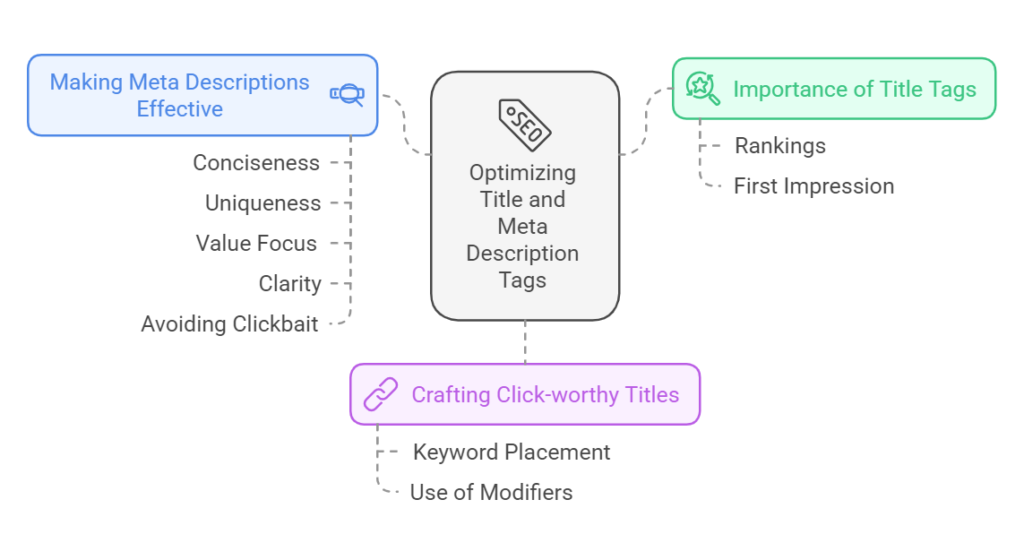
Hey there! Ready to get the inside scoop on crafting killer title tags and meta descriptions? This chapter is your go-to guide for amping up your SEO game in 2025.
Why Bother with Title Tags and Descriptions?
Google itself says that title tags are super helpful for your rankings. They’re your first handshake with the search engine, telling it (and your future visitors) what your page is about. And while Google might not rely on your description to understand your page, people definitely glance at it to decide if your link is worth a click.
Crafting Click-worthy Titles
From my own trenches in the SEO battlefield, I can tell you your title tag is possibly the most crucial on-page SEO element. Why? It’s basically the headline of your ad in the search results. I’ve noticed that having your keyword near the start of the title can seriously boost its power with search engines.
How to Frontload Your Keywords:
Let’s say your post is about image SEO. Instead of a bland title, frontload your keyword to make it pop right off the page:
- Good: Image SEO: Optimizing Your Visuals
- Even Better: Optimize Your Visuals with Image SEO
And about using modifiers – words like “best,” “guide,” “checklist” – they’re like SEO magnets. They pull in those long-tail searches, which can be gold mines for traffic.
For instance, if you’re talking about SEO tools, tagging on “best” and “free” might just help you rank for “best free SEO tools.”
Pro Tip:
Struggling with keyword ideas? Dive into a tool like our free keyword generator. Just tweak your title tags with phrases that your audience might use, like adding “for SEO” to your keyword research tools list. It’s a small change, but trust me, it does wonders.
Making Meta Descriptions Work Harder
According to Google’s SEO guide, even though it might use its own snippet for your page, crafting your own meta description is still a smart move.
Why? Because a compelling meta description can dramatically improve your click-through rate. Think of it as your page’s elevator pitch—it has to be good.
Meta Description Mastery:
Here’s a simple formula I swear by:
- Be Concise: Keep it under 160 characters so it doesn’t get cut off in search results.
- Stay Unique: Make sure each page has its own description to avoid duplicate content issues.
- Focus on Value: Highlight what makes your page a must-see.
- Clarity is Key: Clearly state what the user will find on the page.
- Front-Load Key Info: Put the important stuff right at the beginning.
- Avoid Clickbait: Keep your description true to your content to build trust.
Remember, Google bolds keywords in descriptions that match a searcher’s query, which can give your link visibility a nice little boost.
And that’s the lowdown on optimizing your title and description tags. Keep these tips in hand, and you’re set to create tags that not only rank but also resonate with your audience. Let’s make your content impossible to scroll past!
Crafting SEO Content That Stands Out
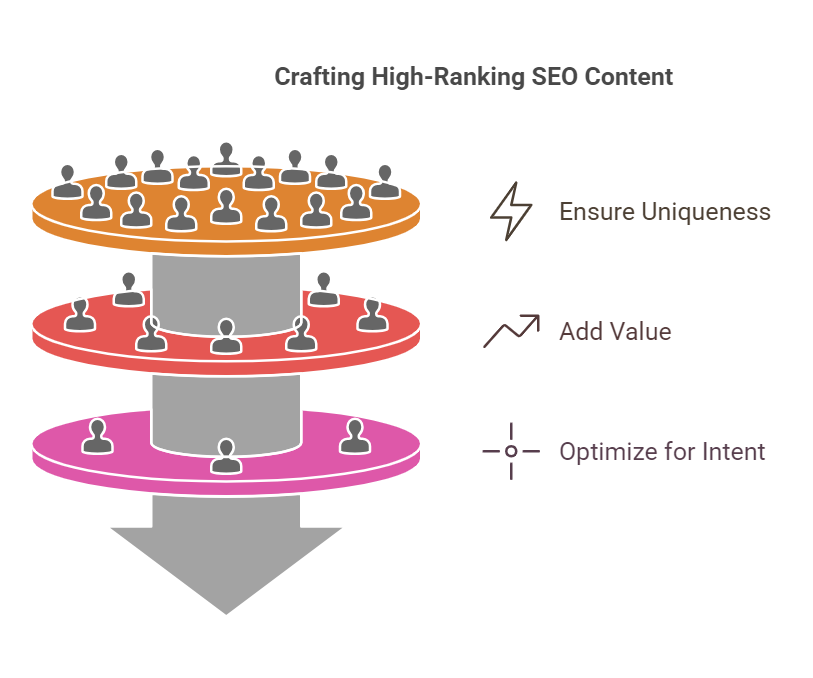
Alright, let’s dive into the art of creating content that’s not just good, but great—content that deserves that coveted #1 spot on Google.
Beyond Keywords: What It Takes to Rank in 2025
Tossing a few keywords into your article isn’t enough to cut it anymore. To really rank your content, it needs to be:
- Unique: It should offer something fresh, not just rehash what’s been said.
- Super valuable: It should provide massive value to your reader.
- Optimized for search intent: It should align perfectly with what your audience is searching for.
In this chapter, I’ll guide you through ensuring your SEO content checks all these boxes.
Embrace Uniqueness
When I talk about unique content, I mean more than just avoiding plagiarism. I’m talking about creating posts that provide new insights or resources that aren’t just recycled from elsewhere. For instance, if you’re crafting an SEO checklist, why not throw in unique tips or a fresh design that sets your content apart from the rest?
Creating Valuable Content
Publishing unique content is a solid start, but to really shine, your content needs to be incredibly valuable. How do you achieve that? Here are a few pointers:
- Detailed: Include images, screenshots, and step-by-step instructions to help your readers apply what they learn.
- Crisp writing: Engage your audience with compelling copy that keeps them reading.
- Updated material: Always offer the latest strategies and examples.
- Expert authors: Content written by someone who has firsthand experience is gold. It’s more likely to be accurate and trustworthy.
For example, the reason my SEO checklist post is so popular isn’t just that it’s thorough; it’s because it starts simple and grows more advanced, offering real, actionable advice every step of the way.
Satisfying Search Intent
Having unique and valuable content can get your foot in the door of Google’s first page. But to stay there? Your content must meet the search intent precisely. That means your page must be exactly what searchers are looking for.
A little while back, I learned this the hard way. I wrote a detailed comparison of top backlink checkers aiming to rank for “backlink checker.” But when I checked the SERPs, I found they were all tools, not blog posts. My content didn’t stand a chance for that term. However, it does rank for “best backlink checker,” a more specific long-tail keyword.
Optimize Your Content for SEO
Hey there! So, you’ve got your content ready, and now you’re diving into the world of on-page SEO. This isn’t just about sprinkling your article with keywords—it’s about structuring your content smartly, making it easy for search engines to see you as the go-to source on your topic.
In this chapter, I’ll share some straightforward strategies that’ll help make your content both findable and lovable by search engines and readers alike.
Starting Strong with Keywords
One timeless tip? Get your main keyword into the first 100 words of your article. For example, if you’re writing about “email marketing,” mention that term right up front. Google pays more attention to words that appear early on your page, so this little move can help set the tone for the rest of your content.
Headings: Your Content’s Roadmap
Think of heading tags (like H1, H2s) as the roadmap for your content. They guide both Google and your readers through your article. Google’s told us that an H1 tag helps it grasp your page’s structure—so make sure your main title is wrapped in an H1, and try to fit your keyword in there if you can.
Keyword Frequency: Getting the Balance Right
It’s not just about having your keyword show up once; it’s about how frequently it appears. Google might say it doesn’t care about keyword frequency, but let’s be real: If your page mentions a specific term several times, it’s probably a good indicator of what the page is about. However, this isn’t a green light to stuff your page with keywords. Just use them naturally, and you’ll be fine.
Strategic Keyword Placement
Remember, it’s not just where your keyword first appears. Here are some prime spots to consider:
- Title Tags and Meta Descriptions: These are essential both for SEO and for enticing people to click from the search results.
- Alt Text for Images: Helps Google understand your images and improves accessibility.
- URLs: Keep them short and sweet, with your keyword included.
Linking Out: Why It’s Worth It
Linking out to reputable sites not only helps Google figure out your page’s topic but also shows that you’re connected to the broader web ecosystem. A study from Reboot Online even showed that pages with outbound links to authority sites tend to rank better.
Optimizing URLs
Your URL isn’t just a web address—it’s a potent part of your on-page SEO. Keep your URLs concise and make sure they include your main keyword. For instance, if your keyword is “link building,” your URL could be as simple as /link-building.
Putting It All Together
Armed with these tips, you’re ready to tweak your content to make it more SEO-friendly. Remember, it’s about more than just following a formula—you want to create content that feels natural and enjoyable to read. Keep it clear, keep it simple, and let your genuine voice shine through. Let’s make your content work smarter for you!
Enhancing Click-Through Rates with Smart SEO Tactics
Hey, let’s chat about something cool we discovered a few years back when we dug into why certain pages get more clicks than others. After analyzing millions of search results, we found that questions in title tags can significantly bump up your click-through rate (CTR).
Why Ask Questions in Titles?
Turns out, question-based title tags catch the eye—our data showed they had a 14.1% higher CTR compared to non-question titles. If someone’s searching for something like “nofollow link,” they’re likely looking for a clear answer. By framing your title as a question, you signal to searchers that your page has the answers they need. For instance, one of my guides on nofollow links uses a question in its title and sees a whopping 27% CTR for that keyword!
Don’t Forget Those Meta Descriptions
Remember when we talked about meta descriptions in Chapter 1? Having one can make a real difference. Even a straightforward description boosts clicks by around 6% compared to pages without any. If you haven’t already, do a quick SEO audit and add descriptions to any pages missing them.
Schema Markup: Your Secret Weapon
While Schema markup won’t directly boost your SEO rankings, it sets the stage for rich snippets, which can seriously enhance your visibility. Rich snippets show extra bits of info like images, ratings, or FAQs right in the search results, making your result stand out more. Consider adding review or FAQ Schema to tap into this feature.
Emotion in Your Titles: A Delicate Balance
Our studies also showed that titles with a bit of emotion get more clicks—about 7% more. However, watch out for going overboard with “power words” like “insane” or “unbelievable,” which can decrease clicks by 12% because they might come off as clickbait.
Update Titles and Descriptions with the Current Year
Adding the current year to your titles and descriptions can also give you an edge, particularly for topics that change rapidly, like technology or trends. It reassures readers that your content is fresh and relevant.
Crafting Content that Captures Attention
Hey, let’s talk about how you set up your content. You know how some posts start with a massive image right at the top? Well, while that can look cool, it’s actually better to have your headline and introduction be the first thing people see when they land on your page.
Optimizing Content Layout
Make sure that if you do use a top image, it doesn’t push your content too far down. You want to grab attention with your words first, not just visuals.
Breaking Down Your Content
In an ideal world, everyone would read every word you write, right? But let’s be real—we need to make our content as skimmable as possible. Here’s what I’ve found works really well:
- Use plenty of H2s: These subheadings break up your text and guide your readers through your article.
- Bullet points are your friends: They help distill complex information into easy bites.
- Images matter: They can explain concepts better than words sometimes and make your post more engaging.
Building a Vibrant Community
Having a buzzing community on your blog can dramatically lower your bounce rate. Why? Because a lively comments section adds so much value—it keeps people on your page even after they’ve finished reading your article. Comments can provide additional insights, alternative strategies, or even spark a little healthy debate.
Here are a few tips to nurture a dynamic community:
- Encourage interaction: Ask your readers to share their thoughts and stories.
- Be responsive: Make sure you jump into the conversation and engage with the comments.
- Celebrate diversity: Welcome different viewpoints; they enrich the discussion.
- Highlight community insights: Showcasing reader comments can make your community feel valued.
- Ask questions: This can be a great way to stimulate further engagement.
By putting these strategies into play, you’re not just building a community; you’re creating an ecosystem where your readers help enrich your content, making it more informative and grounded.
And that’s how you make your content not just seen but savored. Ready to give it a go?
Advanced On-Page SEO Tips
Hey there! Now that you’ve nailed your page’s title and H1 tags, let’s dive deeper into some advanced on-page SEO techniques that are my absolute go-to’s. These are the strategies that really elevate your SEO game.
Going Beyond Generic: Use Original Images
Do you rely a lot on stock images? You might be surprised to learn they could be holding your SEO back. Shai Aharony ran some fascinating tests comparing new sites with stock images against those with original visuals. The verdict? Sites with unique images ranked better. So, if you’re using those common stock photos seen everywhere, it might be time to start creating some custom ones.
The Power of Internal Linking
Internal linking isn’t just about creating a web of links; it’s about boosting your pages strategically. Link from your high-authority pages to those that need a lift, using keyword-rich anchor texts. This simple tactic can significantly enhance the authority distributed throughout your site.
Craft Comprehensive Content
Google loves serving users content that answers all their questions in one go. So, the more comprehensive your content, the better your chances of ranking higher. Incorporate long-tail keywords that cover specific, detailed aspects of your topic. These aren’t just SEO gold; they help ensure your content is thorough.
Speed Up Your Site
Did you know that page speed is a direct SEO ranking factor? Speeding up your site can have a massive impact. From switching to a faster host, cutting down on third-party scripts, to compressing images, every millisecond counts. Tools like Google PageSpeed Insights are great for pinpointing what slows you down.
Optimize Your Images
Since search engines can’t “see” images the way we do, optimized images play a crucial role in SEO. Use descriptive filenames and alt text for each image, and if appropriate, include your target keyword. This helps Google understand your content better and can also boost your presence in image searches.
Get Featured in Snippets
Ever noticed those highlighted answers at the top of Google search results? Landing a spot in a Featured Snippet can drastically increase your CTR. If you’re already ranking on the first page, optimize your content to match the format of existing snippets, be it a definition, a list, or a how-to guide.
Stay On Top of Voice Search
With voice search growing rapidly, creating FAQ pages can be a strategic move. These pages are often pulled into voice search results, helping you capture that audience.
Keep Your Content Fresh
SEO isn’t a set-it-and-forget-it deal. It requires ongoing attention. Regularly update your content to keep it relevant and aligned with the latest search engine algorithms. Monitor traffic trends, bounce rates, CTRs, and keyword rankings to stay on top of your game.
Conclusion
Wow, you’ve made it through this deep dive into on-page SEO—congrats! You’re now armed with the tools and insights needed to fine-tune your content and really make your website shine.
Keen to Explore More? If you’re itching to dive even deeper into the vast world of SEO and digital marketing, why not check out Backlinko’s wide range of detailed guides? From off-page SEO strategies to the nitty-gritty of technical SEO and the art of building inbound links, there’s plenty more to master to stay on top of the ever-changing digital marketing landscape.
Frequently Asked Questions
What’s the difference between off-page SEO and on-page SEO?
Off-page SEO is all about boosting your site’s credibility and traffic from the outside—think link building and social media buzz. On-page SEO, on the other hand, is what you do on your website’s pages to make them more search engine friendly—from your content to your meta tags.
And how does that differ from technical SEO?
Think of on-page SEO as the overall user and content-focused optimization you do on individual pages, whereas technical SEO is all about improving the technical aspects of your site so that it’s easy for search engines to crawl and index.
How often should I tune up my on-page SEO?
On-page SEO isn’t a set-it-and-forget-it deal. To keep your content fresh and ranking well, aim for a monthly check-in. For a more thorough overhaul, a deeper dive every quarter can help align your strategies with any new search engine updates.
What are the must-dos of on-page SEO?
Key moves include optimizing your title tags, meta descriptions, making sure your content uses keywords wisely, streamlining your URLs, and ensuring your images are tagged correctly. Don’t forget, providing a stellar user experience is part of this, too!
Just how crucial is on-page SEO?
It’s huge! Solid on-page SEO is critical for good search engine rankings and ensuring your content reaches your audience. Skimp on this, and you might find your site lost in the depths of search engine results.
Any tools to help with on-page SEO?
Absolutely! Tools like Semrush, Moz, and Ahrefs are lifesavers, offering everything from keyword research to performance tracking. They’re a great help in refining your on-page SEO tactics and keeping your strategy sharp.
So, ready to get your hands dirty and your content seen? Dive into the world of SEO with these insights and tools, and watch your website’s performance soar!
Read More: Boost SEO with 1000+ Powerful Profile Backlink Sites

